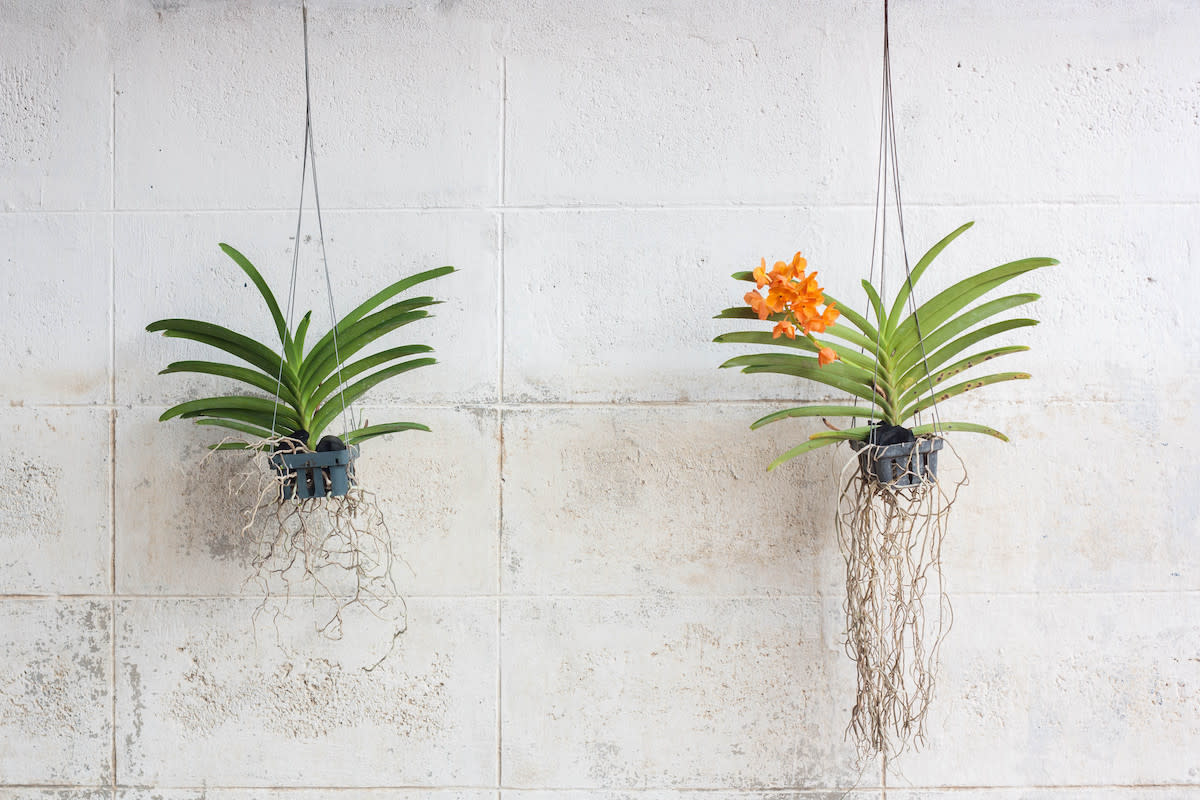Hanging Orchids: How to Grow Orchids in Hanging Baskets
Written by MasterClass
Last updated: Nov 29, 2021 • 4 min read
An orchid is more than just a showy flower to grow in your favorite traditional statement container. Hanging orchids is a great way to create an indoor growing environment for these eye-catching blooms.
Learn From the Best
What Are Hanging Orchids?
Orchids grown in hanging baskets or mounted to a growing surface, like the bark of a tree or a piece of driftwood, are known as hanging orchids. Orchids are epiphytic plants that can grow high up off the soil surface on the bark of a tree, which means that they are amenable to hanging from a ceiling or wall planter.
Hanging orchids can save space in your garden and create vertical interest. Hanging orchids make wonderful houseplants to decorate outdoor patios or verandahs or simply display on walls in your house.
6 Popular Hanging Orchid Varieties
When choosing orchid flowers to hang, it is important to remember that hanging baskets dry out faster than traditional potting, so pick varieties that can withstand dryer conditions. Here are some types of orchids that work well as hanging plants:
- 1. Cattleya orchids: Cattleyas bloom fragrant flowers that come in a variety of colors and forms. This variety is a hardy and slow grower that thrives in USDA Hardiness Zones 10–12. They thrive with plenty of air circulation around their roots, making them a popular choice to hang or mount.
- 2. Vanda orchids: There are roughly eighty species of vanda orchids, most of which bloom several times a year. Vandas are epiphytic plants, meaning they can grow attached to the bark of a tree, making them a great choice for mounting.
- 3. Dendrobium orchids: Dendrobium orchids are epiphytic plants that bloom with flowers all along the flower stems. They grow well in USDA Hardiness Zones 9–12 and thrive as mounted specimens.
- 4. Oncidium orchids: These popular indoor orchids are great specimens for hanging. They thrive in controlled climate conditions and bloom with a wealth of flowers.
- 5. Phalaenopsis orchids: Phalaenopsis orchids are a great flower for beginner planters to cultivate. They are readily available from nurseries and garden centers and require relatively light care. The blooms grow from long thin flower stems, and they grow well in USDA Hardiness Zones 10–12.
- 6. Cymbidium orchids: Cymbidium orchids are some of the most cold-tolerant varieties of orchids. They will continue to bloom throughout winter if cared for properly. They require partial sun and well-draining soil and grow well in USDA Hardiness Zones 10–12.
How to Hang Orchids on a Mount
Follow this simple tutorial to hang orchids on a mount:
- 1. Choose a mounting surface. Choose a mounting material for your orchid that mimics the bark of a tree, like coco husk fiber plaques, cork bar slabs, cypress bark slabs, driftwood, and tree fern plaques.
- 2. Prepare and mount. Soak your mounting surface for two hours (until it is fully saturated) and submerge the orchid’s roots in warm water for twenty minutes.
- 3. Wrap the roots in sphagnum moss. Wrap the root ball of your orchid in sphagnum moss to protect the roots from the sudden change in air circulation as they transition from the potted soil to a mount.
- 4. Tie the plant to the mount. Attach your moss-wrapped orchid to the mount using floral wire, fishing line, or non-biodegradable twine. Use as much wire as you need to secure your plant to the mount. Cut the twine or wire away in a few weeks, once your orchid’s roots attach themselves to the mount.
How to Grow Orchids in Hanging Baskets
Follow this simple DIY tutorial to grow orchids in a hanging basket:
- 1. Choose a basket. Choose an orchid hanging basket that suits your plant’s growing conditions. Wire, wicker, or wooden baskets are all popular choices for hanging orchids. Most wire-hanging baskets will come with a coco husk liner to help contain your orchid's roots. Use hanging clay pots to hang your orchids instead of porous baskets if the variety you’re planting has roots that creep widely.
- 2. Prepare the soil. Fill your hanging planter with orchid potting soil and plant your orchid in the potting medium. Water the soil immediately after planting to ensure the orchid potting mix has adequate drainage.
- 3. Tie the plant to the basket. Attach the orchid stem to the basket with green florist’s wire to prevent it from falling out of the basket as a precautionary measure. You can remove the wire once your orchid's root system attaches itself to the basket,
- 4. Hang in a shady place. Choose a location for your hanging basket that gets partial shade: Too much sun will damage your orchid.
How to Care for Hanging Orchids
Here are some care tips for your hanging specimens:
- Water regularly: Water your potted orchid plants once or twice a week, depending on how well-draining the soil is. Mist your plant’s roots with water from a spray bottle, which keeps them moist while avoiding having to pour water everywhere.
- Fertilize weekly: Feed your orchid once a week with a slow-release organic fertilizer to encourage new growth. Only feed your orchids during their growing period. You don’t need to feed them once they are mature.
- Maintain indirect light: Orchids do not like full sun, but they do need at least ten hours of indirect light every day. Move the mounted orchid pot throughout the day to give them the best light conditions.
Learn More
Grow your own garden with Ron Finley, the self-described "Gangster Gardener." Get the MasterClass Annual Membership and learn how to cultivate fresh herbs and vegetables, keep your house plants alive, and use compost to make your community—and the world—a better place.
